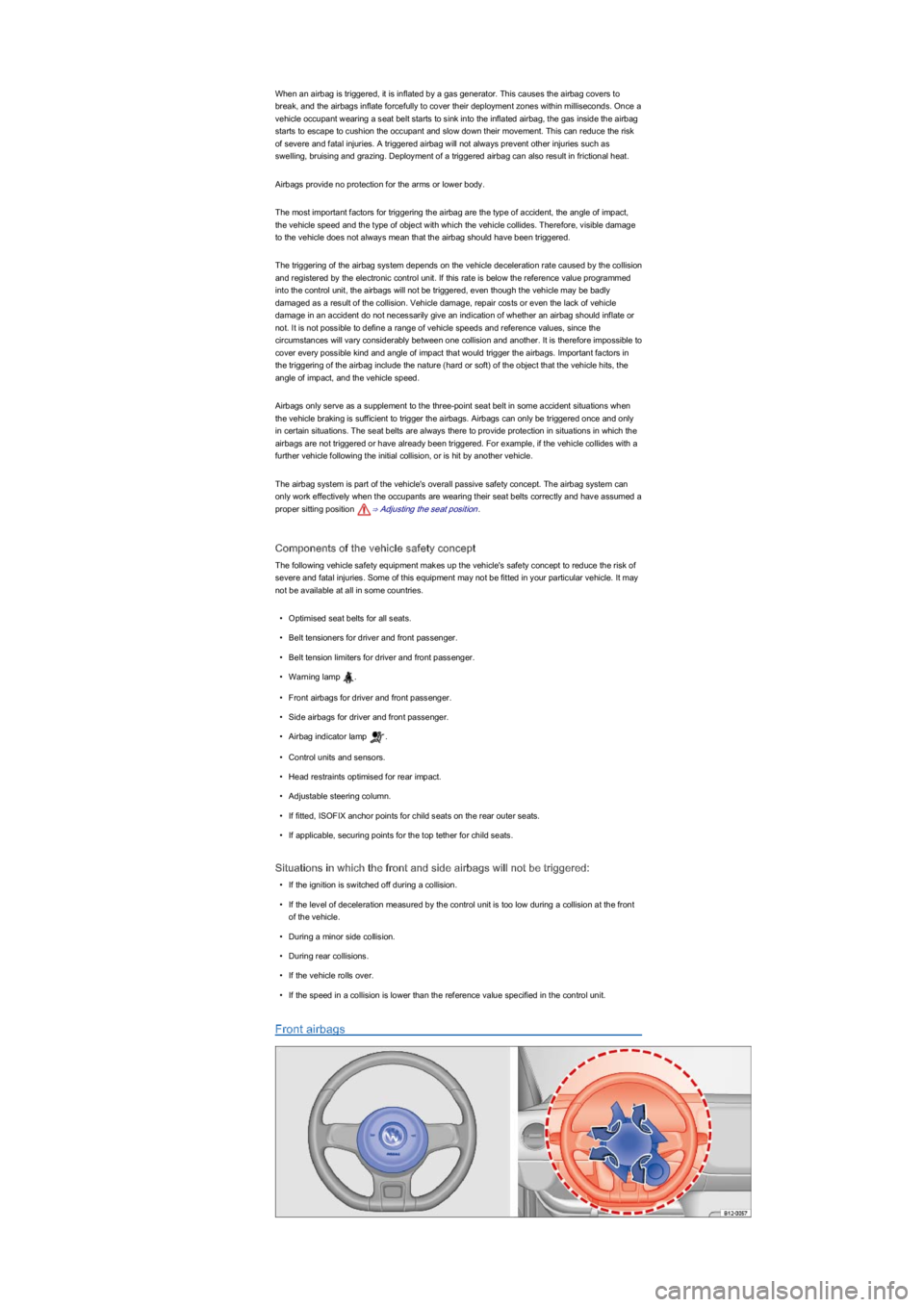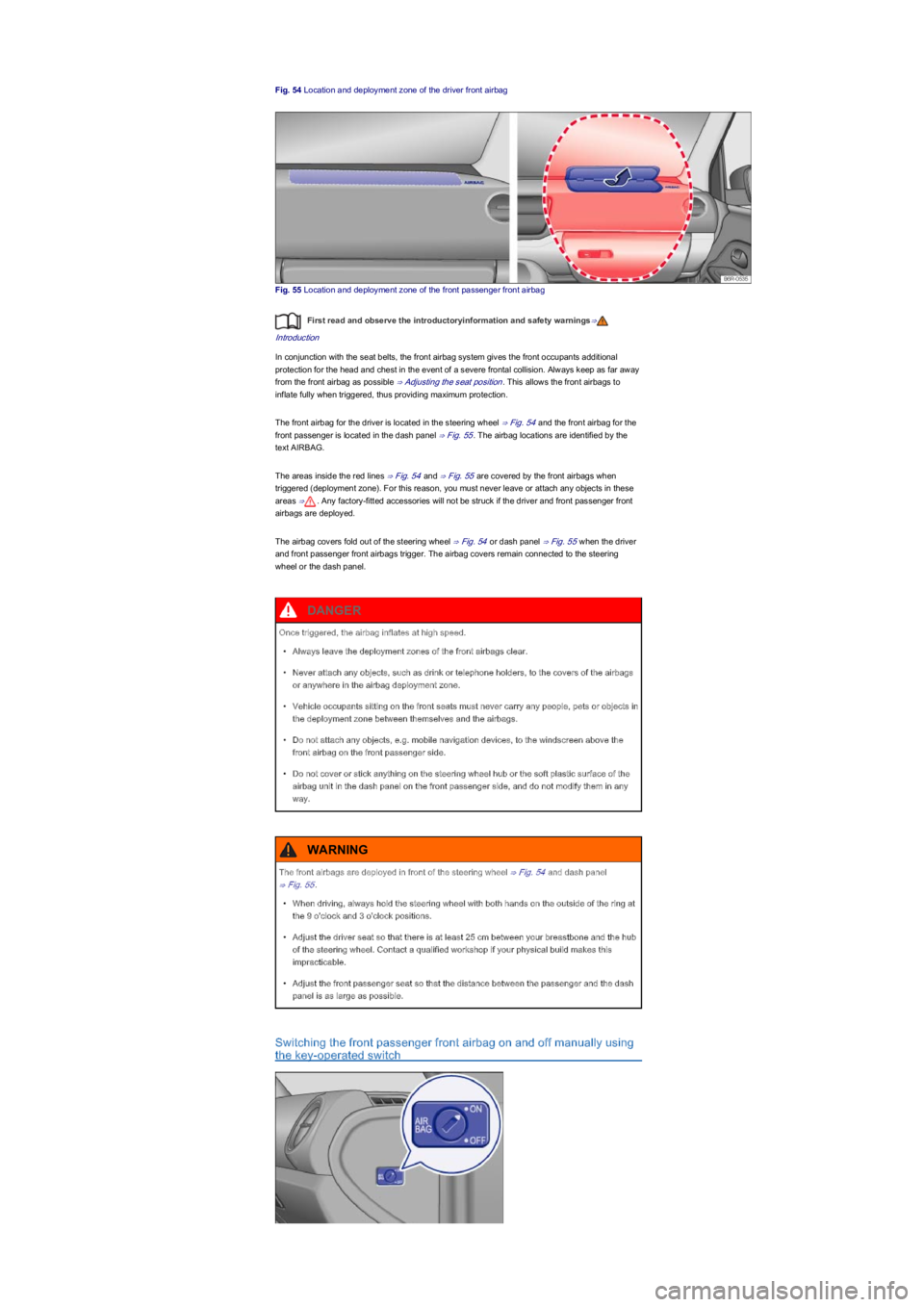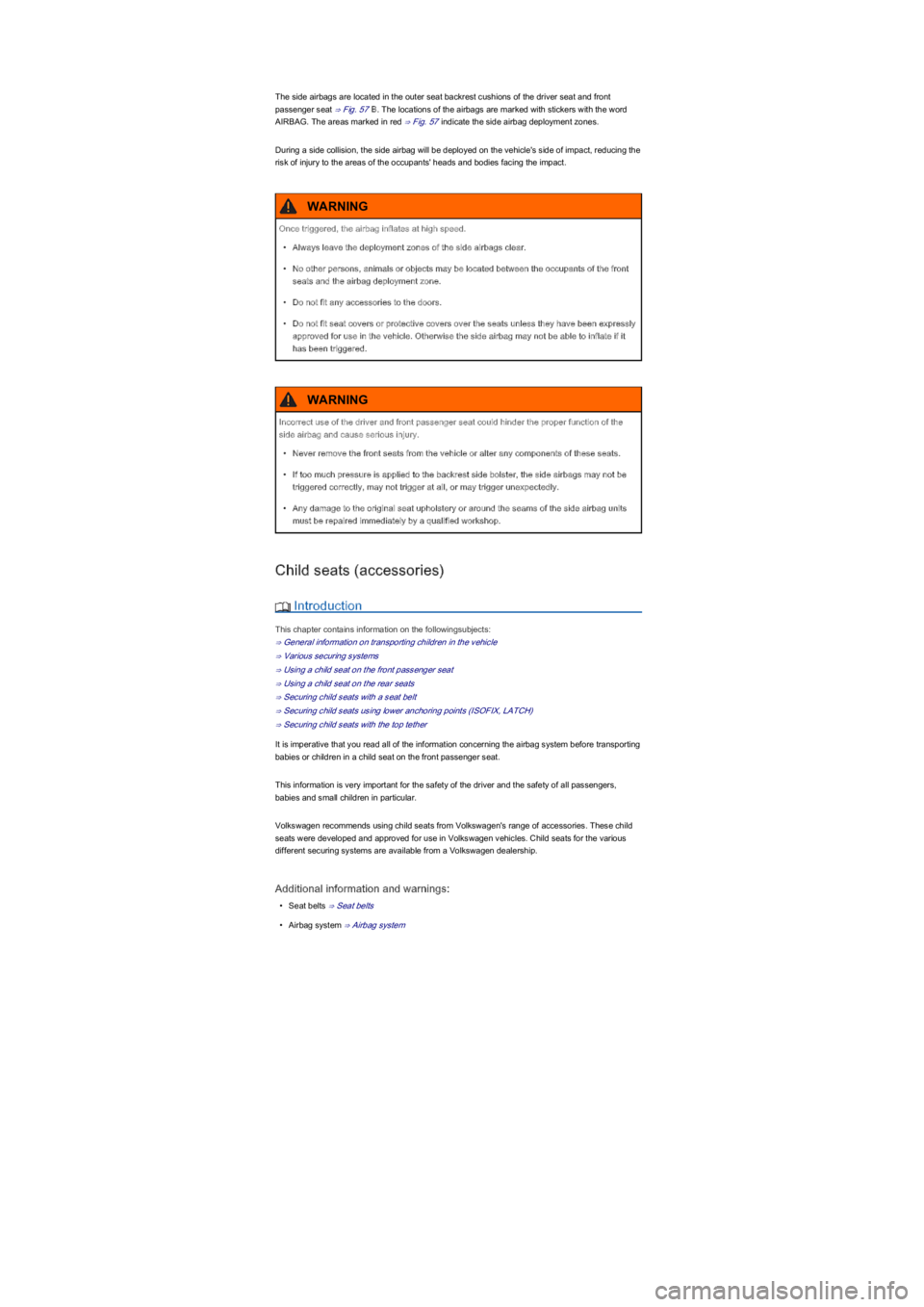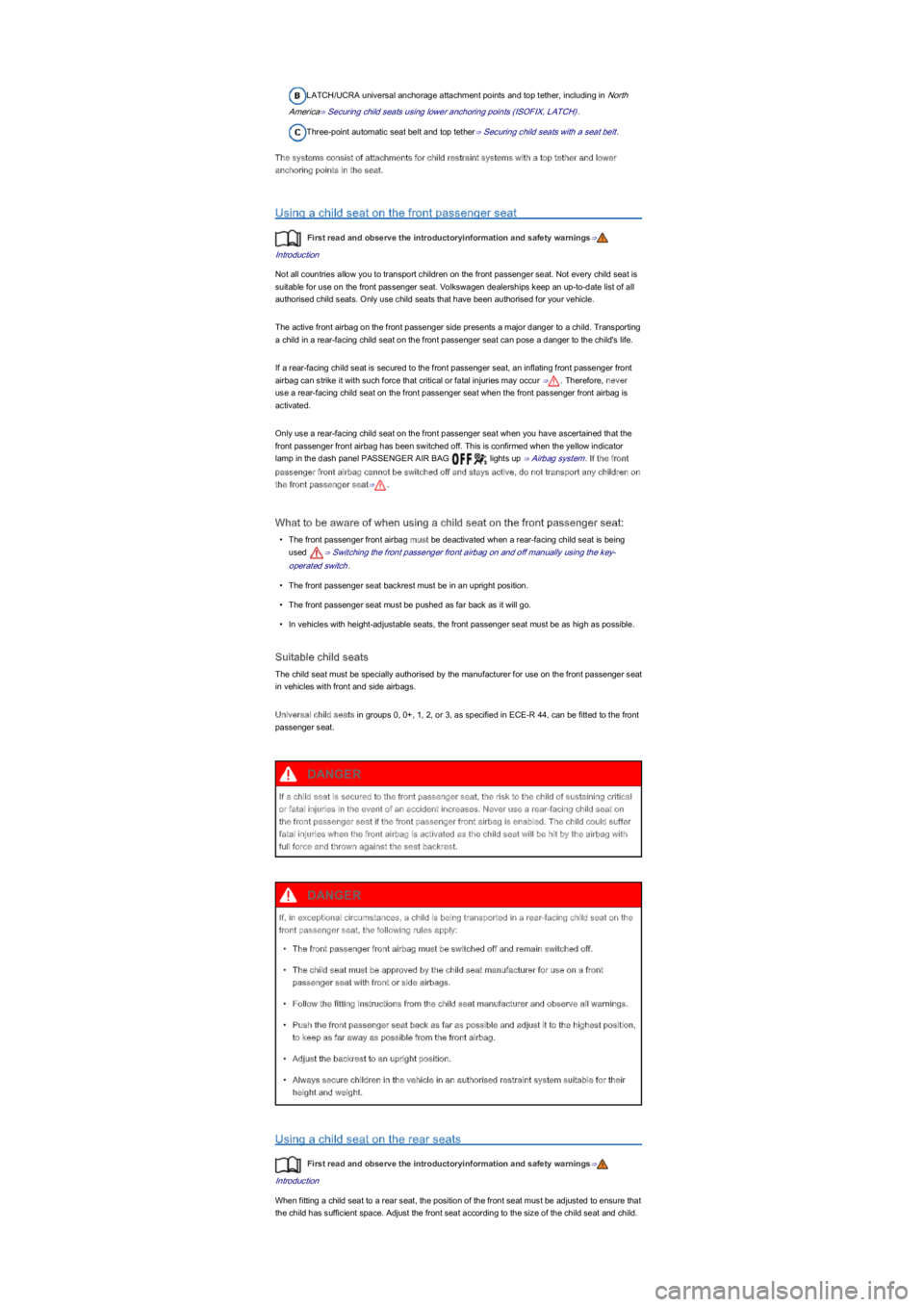Page 48 of 211
Types of front passenger front airbag system
First read and observe the introductoryinformation and safety warnings⇒
Introduction
Never rely solely on the airbag system for your protection.
\f
Page 49 of 211
Volkswagen offers 2 different front airbag systems for front passengers:
AB
Features of the front passenger front
airbag that can only be switched off
by a qualified workshop.
Features of the front passenger front
airbag that can be switched off
manually using the key-operated
switch ⇒ Switching the front passenger front
airbag on and off manually using the key-
operated switch.
\f
Page 50 of 211

When an airbag is triggered, it is inflated by a gas generator. This causes the airbag covers to
break, and the airbags inflate forcefully to cover their deployment zones within milliseconds. Once a
vehicle occupant wearing a seat belt starts to sink into the inflated airbag, the gas inside the airbag
starts to escape to cushion the occupant and slow down their movement. This can reduce the risk
of severe and fatal injuries. A triggered airbag will not always prevent other injuries such as
swelling, bruising and grazing. Deployment of a triggered airbag can also result in frictional heat.
Airbags provide no protection for the arms or lower body.
The most important factors for triggering the airbag are the type of accident, the angle of impact,
the vehicle speed and the type of object with which the vehicle collides. Therefore, visible damage
to the vehicle does not always mean that the airbag should have been triggered.
The triggering of the airbag system depends on the vehicle deceleration rate caused by the collision
and registered by the electronic control unit. If this rate is below the reference value programmed
into the control unit, the airbags will not be triggered, even though the vehicle may be badly
damaged as a result of the collision. Vehicle damage, repair costs or even the lack of vehicle
damage in an accident do not necessarily give an indication of whether an airbag should inflate or
not. It is not possible to define a range of vehicle speeds and reference values, since the
circumstances will vary considerably between one collision and another. It is therefore impossible to
cover every possible kind and angle of impact that would trigger the airbags. Important factors in
the triggering of the airbag include the nature (hard or softyf���R�I���W�K�H���R�E�M�H�F�W���W�K�D�W���W�K�H���Y�H�K�L�F�O�H���K�L�W�V�����W�K�H�
angle of impact, and the vehicle speed.
Airbags only serve as a supplement to the three-point seat belt in some accident situations when
the vehicle braking is sufficient to trigger the airbags. Airbags can only be triggered once and only
in certain situations. The seat belts are always there to provide protection in situations in which the
airbags are not triggered or have already been triggered. For example, if the vehicle collides with a
further vehicle following the initial collision, or is hit by another vehicle.
The airbag system is part of the vehicle's overall passive safety concept. The airbag system can
only work effectively when the occupants are wearing their seat belts correctly and have assumed a
proper sitting position ⇒ Adjusting the seat position.
Components of the vehicle safety concept
The following vehicle safety equipment makes up the vehicle's safety concept to reduce the risk of
severe and fatal injuries. Some of this equipment may not be fitted in your particular vehicle. It may
not be available at all in some countries.
\f
Page 51 of 211

Fig. 54 Location and deployment zone of the driver front airbag
Fig. 55 Location and deployment zone of the front passenger front airbag
First read and observe the introductoryinformation and safety warnings⇒
Introduction
In conjunction with the seat belts, the front airbag system gives the front occupants additional
protection for the head and chest in the event of a severe frontal collision. Always keep as far away
from the front airbag as possible ⇒ Adjusting the seat position. This allows the front airbags to
inflate fully when triggered, thus providing maximum protection.
The front airbag for the driver is located in the steering wheel ⇒ Fig. 54 and the front airbag for the
front passenger is located in the dash panel ⇒ Fig. 55. The airbag locations are identified by the
text AIRBAG.
The areas inside the red lines ⇒ Fig. 54 and ⇒ Fig. 55 are covered by the front airbags when
triggered (deployment zoneyf�����)�R�U���W�K�L�V���U�H�D�V�R�Q�����\�R�X���P�X�V�W���Q�H�Y�H�U���O�H�D�Y�H���R�U���D�W�W�D�F�K���D�Q�\���R�E�M�H�F�W�V���L�Q���W�K�H�V�H�
areas ⇒. Any factory-fitted accessories will not be struck if the driver and front passenger front
airbags are deployed.
The airbag covers fold out of the steering wheel ⇒ Fig. 54 or dash panel ⇒ Fig. 55 when the driver
and front passenger front airbags trigger. The airbag covers remain connected to the steering
wheel or the dash panel.
Switching the front passenger front airbag on and off manually using
the key-operated switch
Once triggered, the airbag inflates at high speed.
\f
Page 52 of 211
Fig. 56 On the front passenger side: key switch for disabling and enabling the front airbag on the
front passenger side
First read and observe the introductoryinformation and safety warnings⇒
Introduction
The front passenger front airbag must be switched off when securing a rear-facing child seat to
the front passenger seat.
Disabling the front passenger front airbag
\f
Page 53 of 211

The side airbags are located in the outer seat backrest cushions of the driver seat and front
passenger seat ⇒ Fig. 57B. The locations of the airbags are marked with stickers with the word
AIRBAG. The areas marked in red ⇒ Fig. 57 indicate the side airbag deployment zones.
During a side collision, the side airbag will be deployed on the vehicle's side of impact, reducing the
risk of injury to the areas of the occupants' heads and bodies facing the impact.
Child seats (accessoriesyf
Introduction
This chapter contains information on the followingsubjects:
⇒ General information on transporting children in the vehicle
⇒ Various securing systems
⇒ Using a child seat on the front passenger seat
⇒ Using a child seat on the rear seats
⇒ Securing child seats with a seat belt
⇒ Securing child seats using lower anchoring points (ISOFIX, LATCHyf
⇒ Securing child seats with the top tether
It is imperative that you read all of the information concerning the airbag system before transporting
babies or children in a child seat on the front passenger seat.
This information is very important for the safety of the driver and the safety of all passengers,
babies and small children in particular.
Volkswagen recommends using child seats from Volkswagen's range of accessories. These child
seats were developed and approved for use in Volkswagen vehicles. Child seats for the various
different securing systems are available from a Volkswagen dealership.
Additional information and warnings:
\f
Page 56 of 211

LATCH/UCRA universal anchorage attachment points and top tether, including in North
America⇒ Securing child seats using lower anchoring points (ISOFIX, LATCHyf.
Three-point automatic seat belt and top tether⇒ Securing child seats with a seat belt.
The systems consist of attachments for child restraint systems with a top tether and lower
anchoring points in the seat.
Using a child seat on the front passenger seat
First read and observe the introductoryinformation and safety warnings⇒
Introduction
Not all countries allow you to transport children on the front passenger seat. Not every child seat is
suitable for use on the front passenger seat. Volkswagen dealerships keep an up-to-date list of all
authorised child seats. Only use child seats that have been authorised for your vehicle.
The active front airbag on the front passenger side presents a major danger to a child. Transporting
a child in a rear-facing child seat on the front passenger seat can pose a danger to the child's life.
If a rear-facing child seat is secured to the front passenger seat, an inflating front passenger front
airbag can strike it with such force that critical or fatal injuries may occur ⇒. Therefore, never
use a rear-facing child seat on the front passenger seat when the front passenger front airbag is
activated.
Only use a rear-facing child seat on the front passenger seat when you have ascertained that the
front passenger front airbag has been switched off. This is confirmed when the yellow indicator
lamp in the dash panel PASSENGER AIR BAG lights up ⇒ Airbag system. If the front
passenger front airbag cannot be switched off and stays active, do not transport any children on
the front passenger seat⇒.
What to be aware of when using a child seat on the front passenger seat:
\f
Page 57 of 211
Ensure that the front passenger can still maintain a correct sitting position ⇒ Adjusting the seat
position.
Suitable child seats
The child seat must have been approved by the manufacturer for use on the rear bench seat with
side airbag.
Universal child seats in groups 0, 0+, 1, 2, or 3 as specified in ECE-R 44 can be fitted to the rear
seats.
The seats are suitable for child seats with the ISOFIX system that are specially approved for this
vehicle type by ECE-R 44.
ISOFIX child seats approved for use on rear seats
There are different categories of ISOFIX child seats: universal, semi-universal and vehicle-specific.
\f